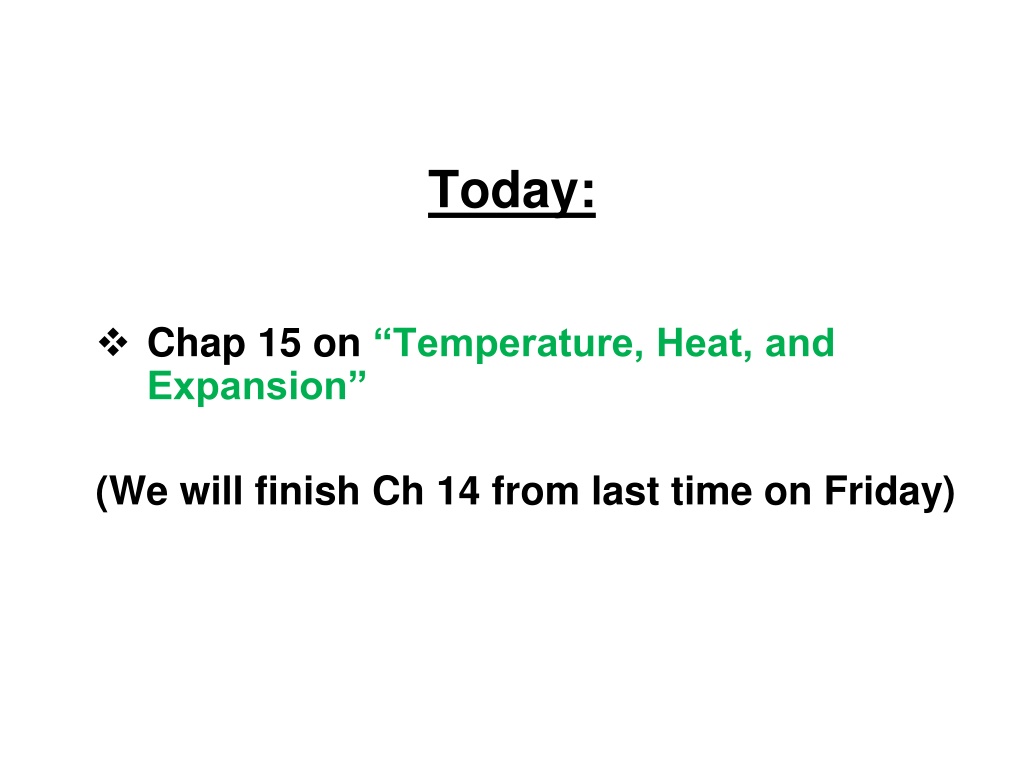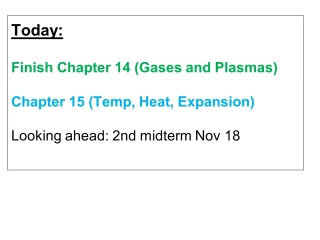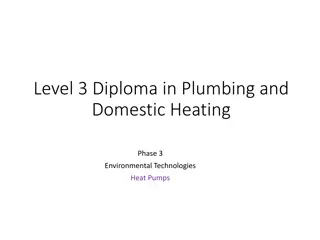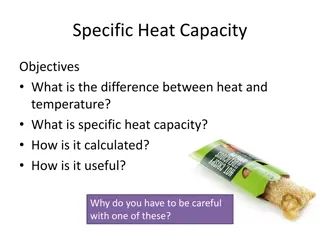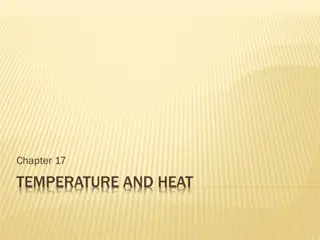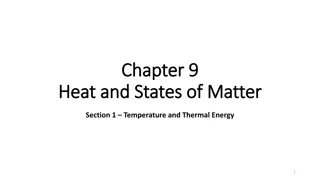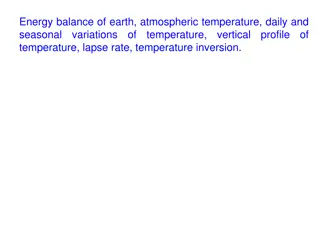Understanding Temperature, Heat, and Expansion in Physics
Exploring the concepts of temperature, heat, expansion, and thermal equilibrium in the context of kinetic energy, energy transfer, and thermometer operation. Different temperature scales like Celsius, Fahrenheit, and Kelvin are discussed, along with the distinction between temperature and heat.
Download Presentation

Please find below an Image/Link to download the presentation.
The content on the website is provided AS IS for your information and personal use only. It may not be sold, licensed, or shared on other websites without obtaining consent from the author. Download presentation by click this link. If you encounter any issues during the download, it is possible that the publisher has removed the file from their server.
E N D
Presentation Transcript
Today: Chap 15 on Temperature, Heat, and Expansion (We will finish Ch 14 from last time on Friday)
Temperature How hot something feels is a measure of the kinetic energy of the constituent atoms/molecules these are continually randomly jiggling. We ll study concepts and relationships between temperature, heat, energy, expansion. Temperature Tells us how warm or cold an object is with respect to some standard. Proportional to the average translational kinetic energy of molecules another, as opposed to rotational or vibrational motion the latter two don t directly affect temperature. i.e. motion carrying molecule from one place to Eg. Microwave oven: microwaves cause water molecules in food to oscillate with considerable rotational KE. But to get the food to cook (i.e. temp to rise), these molecules bounce into neighboring molecules imparting their KE.
Thermometers work by means of expansion or contraction of a liquid. E.g. the common mercury-in-glass thermometer (around 1670 s). Many different temperature scales: (1) Celsius, or centigrade: Assign 0 to the temp at which water freezes, and 100 to the temp at which water boils (at standard atmos pressure). Divide space in between evenly in 100 - each is called a degree , oC. (Celsius was a Swedish astronomer in 1700 s who came up with this) (2) Fahrenheit: used in the US. Assign 32 to temp at which water freezes, and 212 to temp at which water boils. So, 1oF is smaller than 1oC. Will become obsolete if the US ever converts to Celsius like the rest of the world. (3) Kelvin: calibrated in terms of energy, rather than water freezing/boiling points. Assign 0 to lowest possible temperature, where there is no kinetic energy called absolute zero= -273oC. The unit, 1oK = 1oC. All temps are positive on the Kelvin scale.
Themal Equilibrium The expansion of the liquid in a thermometer depends on the liquid s temperature. So how come we say it s reading is the temp of the object surrounding it ?? Because of thermal equilibrium : Energy flows between two objects in contact with each other until they reach the same temperature. The thermometer must be small enough that it doesn t affect the temp of the object you want to measure. E.g. Can measure your body s temp with thermometer but can t measure temp of drop of water with it, since contact between the thermometer and drop can change the drop s temp.
Heat Heat = energy transferred from one object to another due to a temperature difference between them Not a property of the material i.e. don t say an object contains heat , rather heat is energy in transit. (c.f. idea of work) Rather, an object contains internal energy sum of translation kinetic (giving rise to temp), rotational kinetic, vibrational, and potential (from intermolecular forces). Note, temperature is not the same thing as heat ! Eg. Consider boy holding a sparkler 2000oC sparks don t bother him since they are so small very little internal energy although very high temperature Eg. Cup of very high-temp water contains less internal energy than large bucket of warm water.
Heat cont. When heat is absorbed or given off by object, its internal energy changes. It may warm up increase transl. KE. But not always: it may change phase eg add heat to ice - melts to water. When things are in thermal contact, heat always flows from hotter object to cooler object but not necessarily from object of high internal energy to low internal energy. Eg. If spark from sparkler lands in warm water (water has higher internal energy but less temp), heat flows from spark to water. The greater the temp. difference, the greater the heat flow. Also, can get greater heat flow if the amount of hotter substance is larger. Eg. Here, add same amount of heat, so increase the internal energy of both the same. But temp in the one with less water rises more.
Measuring Heat Heat is flow of energy, so is measured in energy units, i.e. Joules. Also, often use Calorie: (or kilocalorie = 1000 cal) 1 calorie = amount of heat required to change temp of 1 gram of water by 1oC. 1 kilocalorie = amount of heat required to change temp of 1 kilogram of water by 1oC. 1 calorie = 4.184 joules. (Note, sometimes kilocalorie is called Calorie, with capital C) Energy rating of foods/fuel is determined by burning them and measuring energy released.
Specific Heat Capacity Different objects have different abilities to retain heat. Eg. Heated apple pie the crust cools off quicker than the inside filling. Eg. Toast cools off much quicker than a bowl of soup. Similarly, same amounts of different objects require different amounts of heat to be raised to the same temperature. Why? Because the applied energy gets apportioned into different proportions of internal vibration/rotation or potential (doesn t raise temp), and jiggling (does raise temp). Eg. Water takes much longer to bring from room temperature to boiling, than it takes same amount of oil to reach same temp. We say water has a higher specific heat capacity (or just specific heat ) than oil. The specific heat capacity of any substance is defined as the quantity of heat required to change the temperature of a unit mass of the substance by 1 degree.
Specific Heat cont. Specific heat is like thermal inertia resistance to change temp when heat is added. Water has exceptionally high specific heat i.e. small amount of water can absorb a lot of heat while only changing temp. a little. 1 gram of water requires 1 calorie of energy to raise temp by 1oC (i.e. specific heat = 1 cal/(K.g)) 1 gram of oil requires 0.5 calorie of energy to raise temp by 1oC (i.e. specific heat =0.5 cal/(K.g)) 1 gram of iron requires 0.125 calorie of energy to raise temp by 1oC (i.e. specific heat = 0.125 cal/(K.g)) So, water is a good cooling agent (eg in cars, engines ) Equally, once heated, it keeps warm for long time (eg. hot-water bottles on cold nights)
Specific Heat of water and climate Water moderates the climate: more energy needed to warm water than to warm land e.g. islands/peninsulas don t have extreme temps like interior lands do Europe is at about the same latitude as parts of northeastern Canada but is not so cold. Why? The Gulf Stream carries warm water northeast from the Caribbean, remaining warm, even up to coast of Europe. Here it cools, releasing energy into the air goes into westerly winds (i.e. winds from the west) to warm Europe. If water didn t have such a high specific heat, Europe would be as cold as northeastern Canada! Ocean doesn t vary its temp much from summer to winter, because of high specific heat so, in winter, it warms the air (air changes temp more, small specific heat), whereas in summer, it cools the air. Hence, westerly winds keep San Francisco warmer in winter, and cooler in summer than in Washington DC even though same latitude.
Thermal Expansion Generally, matter expands when heated, contracts when cooled can understand in terms of increased (heated) or decreased (cooling) jiggling motion of molecules. E.g. Telephone wires become longer and sag on hot day. E.g. Opening a stiff metal lid on glass jar easier to do if hold under hot water for a while since metal expands more than the glass. E.g. NY s Verrazano bridge s roadway is 12 feet lower in the summer than in winter, because of thermal expansion/contraction of the steel cables; Golden Gate bridge (San Francisco) contracts more than a meter in cold weather. Generally liquids expand more than solids. This is important for a glass thermometer filled with mercury liquid mercury expands more than the glass. If not, it wouldn t increase height with increasing temp. Important to account for expansion in building and construction. E.g Filling material for tooth cavities has same rate of expansion as teeth.
Thermal expansion cont. Eg. Concrete roads or bridges are intersected by gaps (often with tar) so concrete can freely expand in summer, contract in winter. Eg. Railroad tracks No gaps in tracks in pic. here, so tracks buckled on a very hot day. Generally, they have gaps that make a clickety- clack sound. Now instead they are welded together to eliminate the sound and laid down on hottest days to avoid buckling due to heat. On cooler days, the tracks contract, but that just stretches the tracks, not distorting them Thermal expansion: The extreme temperature of a July day in Asbury Park, NJ, caused these railroad tracks to buckle and derail the train in the distance. (AP/Wide World Photos)
Thermal expansion cont. Different materials expand at different rates: e.g. brass more than iron Generally, something that expands more when heated, also contracts more when cooled. eg. Bimetallic strip: brass expands and contracts more than iron explains curves in strip shown (outer curve longer than inner) Useful in devices, eg in thermostats, bending in response to tempchange can open/close circuit in a heating or cooling unit.
Other Questions Why is it advisable not to completely fill the gas tank in a car that may sit in sunlight in a hot day after being filled? As it warms, it expands, overflowing and causing a hazard. If place a dented ping-pong ball in boiling water, the dent is removed. Why? so pops back out into a sphere. Because the ball expands as its temp rises,
Anomolous expansion of water All common liquids expand when heated but not water at temps near the freezing point! Ice-cold water at melting temp, 0oC = 32oF, contracts when temp is increased until 4oC, after which it does expand like normal materials: At what temp does water have its greatest density? At 4oC, smallest volume.
When water is solid ice (just below 0oC), its volume is larger, and density smaller (hence ice floats on water). But if further cooled, then it will contract. Ice has crystalline structure open-structured crystals due to angular shape of water molecules. In ice-cold water, most molecules are in liquid phase (water) but also a few ice-crystals here and there.
Understanding the dip in the volume curve: Two competing effects as you add heat to ice-cold water (i) (spaced-out) ice-crystals collapsing decreases volume (ii) faster molecular motion increases volume
The dip explains why organisms can exist in ponds in winter: Consider if there was no dip: so water would continue getting denser through to freezing point (like most liquids). Then coldest water would be at bottom of pond, since it is densest. Organisms would be killed in winter Fortunately, the densest water is at 4oC, so this is the temp at bottom of a pond in winter. Instead, ice (=water at freezing point, 0oC) is less dense so floats to the top, leading to happy fish below at 4oC : Hence, pond freezes from surface downward. As it cools, water sinks until all pond is 4oC. After that, lower temps can be reached and this floats on top and freezes right at top of water is ice at 0oC. This, together with water s high specific heat, means that very deep bodies of water are not ice-covered even in mid-winter need to get whole body to 4oC first, not just the upper part.
